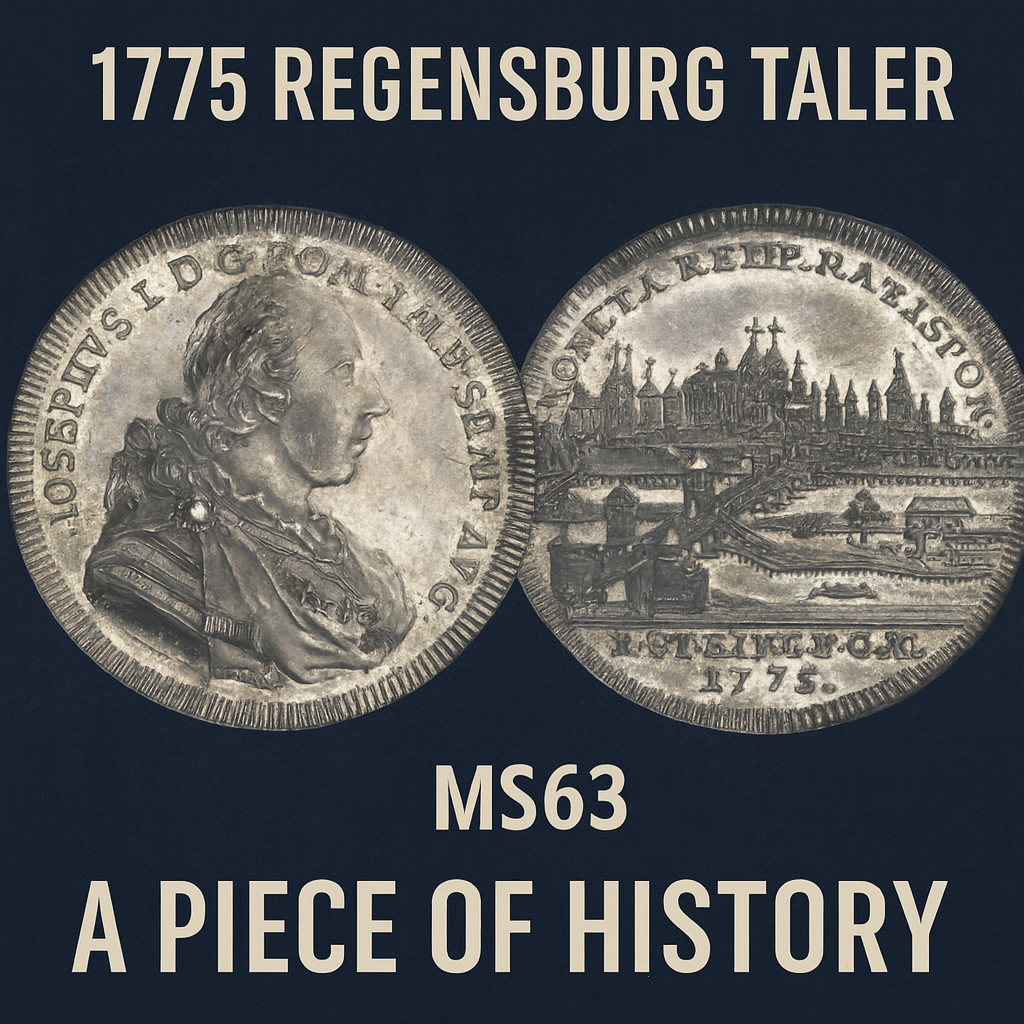Discovering the Legacy of Regensburg: The 1775 Holy Roman Empire DAV-2626 Taler

For investors, collectors, and history enthusiasts alike, antique coins are not just tangible assets—they are portals into the cultural, political, and economic soul of a past civilization. Among them, the 1775 DAV-2626 Taler from the Free Imperial City of Regensburg stands out as a historically rich and visually captivating masterpiece. Let’s explore why this coin deserves a place in the portfolios of discerning collectors and investors around the world.
1. A Glimpse into the Holy Roman Empire's Political Heart
In 1775, Regensburg (Ratisbon), a Free Imperial City within the Holy Roman Empire, struck this taler under the authority of Emperor Joseph II. Known for his Enlightenment-driven reforms, Joseph II symbolizes the empire's pivot from feudal rigidity toward religious tolerance and administrative modernization.
This coin commemorates that transformation. With the emperor’s armored bust gracing the obverse and a panoramic city view of Regensburg on the reverse, the taler visually narrates the duality of power and civic pride. Its Latin inscriptions—“IOSEPHVS II D·G·ROM·IMP·SEMP·AVG” and “MONETA REIP. RATISPON.”—proclaim the emperor’s divine authority and the city’s minting rights.
For collectors, this is not just silver; it's sovereignty and symbolism struck in metal.
2. A Work of Art in Silver
Beyond history, the 1775 taler is a testament to 18th-century artistry. Measuring over 42 mm and weighing approximately 28 grams, this large silver coin was struck during a transitional period between manual and machine minting. The obverse portrait, designed by master engraver Körnlein, features fine detail down to the laurel crown and the insignia of the Order of the Golden Fleece.
Flip the coin over, and you're treated to a breathtaking cityscape: Regensburg’s iconic stone bridge crossing the Danube, riverside towers, boats, and gothic spires—all engraved with surgical precision. It’s a miniature view of one of the empire’s most politically important cities, preserved for eternity.
Few coins in numismatics offer this level of scenic storytelling.
3. Investment Potential: Scarcity, Grade, and Demand
Coins like the DAV-2626 Taler are not minted for mass distribution. They were often ceremonial, struck in small numbers to honor events or assert municipal autonomy. As a result, surviving examples are scarce, and those in top condition are even rarer.
The featured example is graded MS63 by NGC, placing it among the finest known. Most surviving talers from this era fall well below this grade due to centuries of wear or improper cleaning. In fact, even MS62 examples have fetched over $3,000 at major auctions in recent years.
With its combination of high grade, historical significance, and aesthetic appeal, this taler fits squarely in the category of “blue-chip” numismatics—highly sought after, slow to depreciate, and increasingly hard to find.
4. Why This Taler Matters for Today’s Collectors and Investors
As global markets fluctuate, tangible assets like rare coins are seeing renewed interest, especially among those looking to diversify wealth outside traditional instruments. The 1775 Regensburg Taler is a perfect storm of value drivers:
-
Historical Context: Tied to an Enlightenment emperor and a politically pivotal city.
-
Scarcity: Low surviving population, especially in uncirculated grades.
-
Artistry: One of the most detailed cityscape coins of the 18th century.
-
Market Strength: Strong auction performance and sustained collector demand.
Whether you're a seasoned collector or a newcomer to rare coins, this taler offers the thrill of owning a piece of European history—and the promise of long-term value appreciation.
Final Thoughts
The 1775 DAV-2626 Regensburg Taler is more than a coin—it's a story in silver. It reflects a moment of transformation in the Holy Roman Empire, a celebration of civic identity, and a remarkable feat of numismatic design.
For those seeking a rare, visually striking, and investment-grade artifact, this taler deserves a closer look. As with all great collectibles, opportunities to acquire specimens of this quality do not come often.
Own a piece of the past. Invest in legacy.
